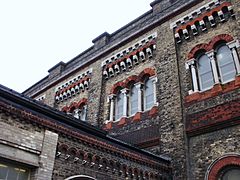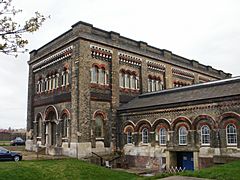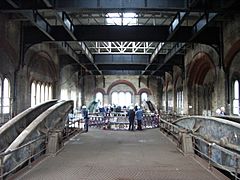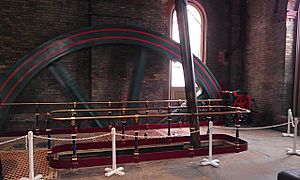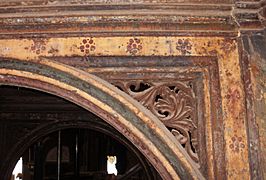Crossness Pumping Station facts for kids
Quick facts for kids Crossness Pumping Station |
|
|---|---|
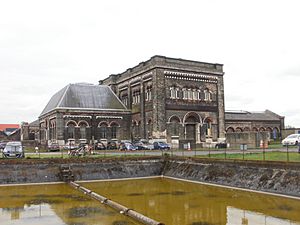
Western exterior of the Crossness Pumping Station
|
|
| Location | Crossness Sewage Treatment Works London, SE2 United Kingdom |
| OS grid reference | TQ4849781080 |
| Built | 1859–1865 |
| Architects | Charles Henry Driver |
| Architectural style(s) | Romanesque |
| Owner | Thames Water |
|
Listed Building – Grade I
|
|
| Designated | 24 June 1970 |
| Reference no. | 1064241 |
| Lua error in Module:Location_map at line 420: attempt to index field 'wikibase' (a nil value). | |
The Crossness Pumping Station is a very old building in London. It was built to help clean up the city's sewage. This huge station was designed by Sir Joseph Bazalgette, a famous engineer. It is located in the London Borough of Bexley.
The station was built between 1859 and 1865. It was a key part of Bazalgette's plan to improve London's sewer system. The building is famous for its amazing metal decorations. One expert called it "a Victorian cathedral of ironwork." The station stopped working in 1956. But it has been beautifully fixed up and opened to visitors in 2016.
Next to Crossness is the Erith Marshes. This area is a special nature reserve. It is home to many animals, like moths, small amphibians, and water voles.
Contents
A Grand Opening
The Crossness Pumping Station was officially opened on April 4, 1865. Many important people attended the event. These included Edward, Prince of Wales, and other royal family members. The Lord Mayor of London was also there.
Joseph Bazalgette gave a speech. Then, the royal guests looked around the station. The Prince of Wales turned a wheel to start the giant engines. People felt a big shake as the huge machines began to work. It was a very exciting moment!
How the Station Worked
At Crossness, the dirty water was lifted about 30 to 40 feet (9 to 12 meters). This was done by four huge steam-powered pumps. These engines were enormous and very powerful. They were built by James Watt & Co. and named "Victoria", "Prince Consort", "Albert Edward" and "Alexandra".
Each engine could pump about 6 tons (or 6,800 liters) of sewage per stroke. This happened 11 times a minute! The sewage was pumped into a giant 27 million imperial gallon (123,000 cubic meter) reservoir. It was then released into the Thames river when the tide was going out. To power these engines, 12 large boilers burned 5,000 tons of coal every year.
At first, Crossness just sent raw sewage into the river. But in 1882, experts said that the solid parts of the sewage should be removed first. So, in 1891, special tanks were added. These tanks separated the solid waste, called sludge. Steam boats then carried the sludge far out into the river estuary and dumped it at sea.
Later, more pumping power was needed. In 1897, four new pumps were added. These used more advanced steam engines. In 1899, the original engines were also made more efficient. They were upgraded to work even better.
By 1913, the steam engines were replaced with diesel engines. These diesel engines can still be seen today. The original Watt-Goodfellow steam engines stopped working by 1956. One engine, "Prince Consort," was briefly used again in 1953 to help with flooding. After that, the engines and ironwork were left to rust.
Bringing Crossness Back to Life
When the pumping station closed in the 1950s, it was too expensive to take the engines apart. So, they were left behind. Many valuable metal parts, like brass oilers and handrails, were stolen. The building and engines slowly fell apart.
In 1970, the pumping station became a Grade I listed building. This means it is a very important historical site. In 1987, a group called the Crossness Engines Trust was formed. Their goal was to fix up the station. The four pumping engines are believed to be the largest beam engines still existing in the world. They have huge 52-ton flywheels!
The "Prince Consort" engine was the last one to stop working. So, the Trust focused on restoring it first. After 15 years of hard work, "Prince Consort" was working again by 2003. It now runs on special open days. Work has also started on restoring the "Victoria" engine.
Restoring the station was a big challenge. The areas under the engines were filled with sand to prevent gas buildup. Workers had to dig out about 100 tons of sand! Also, rainwater had caused a lot of rust on the engine parts. The original boilers were gone, so a smaller, modern boiler is now used to power "Prince Consort."
The Crossness Museum
The Crossness Pumping Station received over £2 million in funding. This money helped build an access road and protect the buildings. It also helped create a museum. Major support came from the Heritage Lottery Fund and English Heritage.
In April 2015, the station received another £1.5 million. This was for a new museum exhibit. It focuses on the "Great Stink" of 1858. This was a time when the Thames river smelled terrible due to sewage. The exhibit shows how Crossness helped solve this problem.
Crossness Pumping Station opened to the public in 2016. The Guardian newspaper called it a "glorious monument" to amazing Victorian engineering.
Gallery
See also
- Abbey Mills Pumping Stations – another important pumping station in London.
- Markfield Beam Engine and Museum



